Sanjar-Shah Excavations 2022
Michael Shenkar, Sharof Kurbanov, Abdurahmon Pulotov and Firuz Aminov
with an Appendix by Maria Gervais
This season the excavations were continued in Area VI where we completed the investigations of the pottery kiln first excavated in 2019. However, our main efforts were concentrated on the Palace situated in the western part of the site (Areas VII-VIII) expanding the area to the southwest. We have investigated five rooms (12-17) that were probably part of the huge, rectangular Throne Room of the Palace (Figs. 1-4). Fourteen fragments of wall painting were uncovered in the fill of Rooms 12, 13 and 15. They were excavated by the restorer specialist from the State Hermitage Museum, Maria Gervais assisted by Manuchehr Rahimov from the National Museum of Antiquities, Dushanbe.
Area VI
Limited investigations were conducted in this area in order to complete the excavations of the pottery kiln, which was partly excavated in 2019 (Fig. 5). It is located in Room 11 at a distance of 1.9 m to the west, and 2.3 m to the south from the limits of the excavated area. The kiln is attached to Walls 10 and 13. It is round, 2.1 m diameter inside, 2.8 m. outside. The opening is from the east, air openings are made in the floor, and outside on the north-eastern side, there is an opening for ventilation. In 2019 we were unable to find the furnace. Initially, we assumed that the furnace opening was located in Room 12. This room is very small and has no passage. The access to Room 12 was probably by ladder.
In 2019, a floor level was found at the depth of 1.05 m from the surface of Wall 10. In order to find the furnace we excavated below the floor and at the depth of 40 cm there was layer of gravel. At the depth of 20 cm from the floor level, a coin of a Kushan king Vasudeva was found (Fig. 23). It seems that it was brought here together with the soil from another place. The furnace was found in the north-western part of the kiln, at a distance of 1.7 m to the north from the southern side of the opening of the upper part. The opening of the furnace is of oval shape (50 x 50 cm) (Fig. 6). Its surface bears traces of intense burning. The floor of the furnace is 40 cm lower than the floor of Room 11.
Area VIII
Room 12
This room (2.5 x 10.5 m) is situated to the south of Room 2, to the east of Rooms 13 and 15, and to the north of Room 17 (excavations not yet completed). It is a rectangular corridor aligned on the north-south axis (Fig. 7). Wall 11a (h. 88 cm from the sufa level; w. 110 cm) is constructed of pakhsa blocks (90-110 x 110 x ? cm). Wall 11a is attached to Wall 11. Wall
11a has a bonding with Wall 16 and has no bonding with Wall 19. In the southern direction, Wall 11a was excavated for 11.6 m, and it continues further south. A layer of plaster (2.5-3 cm) is preserved on the wall.
Wall 16 (h. 80 cm from the sufa level; w. 124 cm) is also built of the pakhsa blocks of the same dimensions. Similarly, a layer of plaster (1.5-2.5 cm) is preserved in some places on the wall surface.
Wall 15 (h. 1.5 m from the floor level; w. 185 cm) is constructed differently. Up for the height of 70-75 cm, it is built of seven rows of mud-brick (51-52 х 24-25 х 8-9 cm). The wall’s surface is irregular. At some places, bricks project from the wall for 1-3 cm or are submerged into it. Above it, the wall is built of pakhsa blocks (165-120 х ? х185 cm). Wall 15 stands on the floor of the first period. It is attached to Wall 19 and has a bond with Wall 14.
There are no traces of plaster on the surface of the wall.
Wall 19 (h. 147 cm from the floor; w. 110 cm) is constructed of the pakhsa blocks (120 х 110 х ? and 50 х 110 х ?). It is attached to Wall 11a and continues to the west forming the southern wall of Rooms 14 and 15. This wall was not plastered.
A sufa (h. 70 cm; w. 110 cm in the southern part and 120 in the northern) was constructed along Wall 11a. It is constructed of mud-brick (51-52 х 24-25 х 9-10 cm) and plastered (2-3 cm).
The floor surface in the room is solid, slightly declining towards the west, and shows traces of fire. Importantly, it goes under Wall 15, and thus this wall was constructed in the later period on the early floor.
The fill in the room consists of rammed earth and stones of various dimensions. Two fragments of wall paintings (P1 an P2) were found in the room. The finds include a fragment of an onyx bead from the topsoil (Fig. 25.5), and two objects made of bone from the fill (Fig. 24.1-2). One of them is perhaps a sumak.[1]
Room 13
This room (15.6 x 2.4 m) is located to the south of Room 2, to the west of Room 12, and to the north of Room 15 (Fig. 8). It is a rectangular room arranged on the west-east axis. In this room in Wall 16 at a distance of 135 cm from Wall 11a, there is a blocked passage (w. 185 cm) to the north (Fig. 9). This passage is wider than other passages investigated so far in the Palace. The passage is blocked with mud-brick (51-53 х 24-26 х 8-9 cm).
Along Wall 16 there is a sufa (l. 8.47 m; w. 120 cm) with a central projection (l. 2.72 m) for 55 cm from the line of the sufa. It is made of mud-brick (51-52 х 24-26 х 9 cm). The western end of the sufa corresponds to the eastern side of the blocked passage. This sufa has a bond with the sufa built along Wall 11a.
Wall 12 (h. 150 cm; w. 140 cm) is built of pakhsa blocks (90-110 х 110 cm). It the northern part, it seems that the wall is blocked with mud-brick (51-52 х 24-26 х 8-9 cm). The surface of this addition is irregular. Its lower part projects from the wall for some 10 cm. It is possible that originally, there was a niche in this place that was later blocked.
At the distance of 140 cm from Wall 16, there is a sufa (w. 145 cm; h. 60 cm) along Wall 12. This season it was excavated for the length of 110 cm. At the distance of 115 cm from Wall 16 in the northern end of the sufa, there is a step (h. 30 cm; w. 30 cm; l. 37 cm) (Fig. 10).
Wall 14 (l. 10.87 cm; w. 183 cm) is constructed using the same method as Wall 15. The floor in the room is relatively smooth, slightly degrading in the central part. At some places, there are traces of fire that destroyed the Palace at the end of the first period. It is worth noting that like in Room 12, also here the floor goes beyond Wall 14.
Ten fragments of wall paintings (P4-6, 8, 10-14) were found in the fill between Wall 14 and the projection of the sufa. Other finds in the room that come from the topsoil and the fill include a stone bead (Fig. 25.6), two fragments of rim of glass vessels (Figs. 26.2-3), fragment of a bottom of a glass vessel (Fig. 26.4).
Room 14
This rectangular room is situated to the south of Room 13 and to the west of Room 15 (Fig. 11). This season it was only partially excavated (2.4 x 1.9 m) until the sufa level. Wall 12 (h.
90 cm from the sufa level) is constructed of pakhsa blocks (90-110 х 110 х ?).
Wall 19 (h. 90 cm from sufa level; w. 1.5 m) is built of mud-brick (49-50 х 24-25 х 89 cm). It is attached to Wall 12. Wall 13 (h. 90 cm from the sufa level; w. 1.85 m) is made of pakhsa blocks (120 х 120-140 х ? cm). The sufa in the room is built of mud-brick (50 х 25 х
9 cm) and its upper surface is plastered. This layer of plaster connects it with Wall 12.
Room 15
This is a rectangular room (7 x 6.2 m) situated to the south of Room 13, to the east of Room 14 and to the west of Room 12 (Figs. 12-13). This season the floor of the first period was exposed only in the central part of the room. Wall 15 (h. 105 cm; w. 1.85 m) is built of pakhsa blocks (165-120 х 185 x ? cm). It is attached to Wall 19 and has a bond with Wall 14. The wall was not plastered.
Wall 16 (h. 100 cm; w. 183 cm) is constructed using the same building technique. Here too, no plaster was preserved. At a distance of 2.8 m from Wall 13, there is a niche or a beam pocket (30 х 20 x 12 cm) in the wall. In the north-western corner of the room, between Walls 13 and 15, there is another beam pocket (32 x 28 x 8 cm). Wall 13 (h. 80 cm; w. 185 cm) is attached to Wall 19 and made of pakhsa blocks (120 х 120-140 х ? cm). At a distance of 2.52 m from Wall 19, there is a beam pocket (45 x 22 x 20 cm). Wall 19 (h. 85 cm; w. 110 cm) is also built of pakhsa blocks (120 х 110 х ? cm and 50 х 110 х ? cm).
This season the excavations reached the accumulation of stones at the depth of 80-105 cm from the top of the walls (Fig. 14). Such accumulations were identified along Walls 14 and 15 and in the north-western corner. In the central part of the room, our excavations reached the floor of the first period where Fragments 7 and 9 of wall paintings were found.
Room 16
This room was only partially excavated this season for the area of 2.65 x 1.6 m (Fig. 15). It is situated to the south of Room 14. Wall 12 (h. 70 cm) is built of pakhsa blocks (90-110 х 110 х ?) cm. On the inner surface of the wall, there is a layer of plaster (1.5-2 cm). The total length of Wall 12 exposed so far is 17.6 m. It is important to note that this is not the final length, as the wall continues further south. Its final length will be established next season.
Wall 19 (h. 70 cm; w. 1.5 m) is constructed of mud-brick (49-50 х 24-25 х 8-9 cm) and attached to Wall 12. Wall 17 (h. 95 cm) is built of mud-brick (49-51 х 24-26 х 8-9 cm). It is attached to Wall 19 and continues further south.
Room 17
This room situated to the south of Room 12 was excavated for 4.3 x 3.9 m (Fig. 16). Two phases of the later, second period were identified here. At the depth of 75 cm from the daily surface there was an irrigation ditch going from north to south extending beyond the borders of the excavated area in the south. Stones were found in the ditch.
Below the irrigation ditch, walls belonging to the first phase of the second period were found. Wall 19 (h. 70 cm) is built of pakhsa blocks. Wall 11a (h. 80 cm) continues to the south and it was used also in the first period. Wall 18 (h. 45 cm) is built of mud-brick of standard dimensions.
Wall paintings
The “Main throne room” of the palace was originally lavishly decorated with wall paintings. Several large and medium fragments were found in the fill and were excavated and conserved by our restorers (Fig. 17). The paintings were made on a blue and black background. The preserved fragments depict a rhombi design (Fig. 18), a complex and sophisticated floral freeze with the blue flower bud (Fig. 19), a decorative ornament of crenelated antefixes (Fig. 20), and a figurative composition of characters wearing Sogdian priestly garments (Figs 19, 21-22).
Two figures were partially preserved. One of them raises a small, portable fire altar in his hand. Next to him, there is a niche with fragmentary preserved big tongues of flame. Usually, such tongues of flame are part of divine nimbus in Sogdian art, and indeed decorating the main wall above the sufa projection with a large image of a deity inside a painted arch is typical for the wealthy Sogdian houses and palaces. However, it seems that there is not enough space under the arch to accommodate the figure of a deity. It is, therefore, possible that some object, most probably a stationary fire altar like the one on the Molla Kurgan ossuary was depicted under the arch. Depictions of priests are known from ossuaries, but it is the first time they are attested in wall paintings.
The Sanjar-Shah paintings are of the highest artistic quality and are outstanding monuments of Sogdian art. They resemble most closely the paintings from the Shahristan palace, which comes as no surprise, since the plan of the Sanjar-Shah palace itself and fragments of carved wood from Sanjar-Shah recovered in 2021 are very close to those from Shahristan. The results of our excavations will allow suggesting a date of 740s for the construction of the Shahristan palace, which was debated and controversial for over 50 years.
Conclusions and further prospects
It appears that Walls 11a, 12 and 16 belong to the first building period and are in fact part of a huge, rectangular hall, most probably the Main Throne Room of the palace. Its width in the north is 15.6 m. The length of Wall 12 excavated this season is 17.6 m and it continues in the southern direction. The final length of the Main Throne Room will be established next season. In the second period, additional Walls (13-15, 17-19) divided the throne room into smaller rooms, similar to what was done with the Large Square Hall to the east. Especially enigmatic is Room 15, where no passage was found so far. Still in the second period, but at a later date, the building went out of use and the surface was used for agriculture.
Next season we will continue the excavations of the Palace in order to establish the plan and the exact dimensions of what was probably the Main Throne Room of the SanjarShah palace. The fragments of wall paintings excavated this season will undergo cleaning and restoration process. We hope that next season will bring new finds of the monuments of Sogdian art and possibly evidence about its original owner.
Figures

Fig. 1. Sanjar-Shah, general plan of the excavated areas, 2022. By Elena Bouklaeva.

Fig. 2. Sanjar-Shah 2022, Areas VII-VIII, by Elena Bouklaeva.

Fig. 3. Sanjar-Shah 2022, Area VIII, by Elena Bouklaeva.

Fig. 4. Sanjar-Shah 2022, general view of the Palace (Areas VII-VIII) looking east.

Fig. 5. Sanjar-Shah 2022, Area VI, by Elena Bouklaeva.

Fig. 6. Area VI, Room 11. Opening of the pottery kiln furnace.

Fig. 7. Area VIII, Room 12 looking north.

Fig. 8. Area VIII, Room 13 looking west.

Fig. 9. Area VIII, Room 13. Blocked passage in Wall 16.

Fig. 10. Area VIII, the western part of Room 13.

Fig. 11. Area VIII, Room 14 looking north.

Fig. 12. Area VIII, Room 15 looking south.

Fig. 13. Area VIII, Room 15 looking east.

Fig. 14. Area VIII, Room 15, accumulation of stones in the northwestern corner.

Fig. 15. Area VIII, Room 16 looking south.

Fig. 16. Area VIII, Room 17 looking north.

Fig. 17. Area VIII, Room 13. Distribution of fragments of wall paintings, by Maria Gervais and Elena Bouklaeva.

Fig. 18. Area VIII, Room 12. Fragment of wall paintings (P1) depicting a lozenge pattern

Fig. 19. Area VIII, Room 13. Fragment of wall paintings (P3) depicting a floral freeze and an upper part of a fire altar.

Fig. 20. Area VIII, Room 15. Fragment of wall paintings (P7) depicting an ornament of crenelated antefixes.

Fig. 21. Area VIII, Room 15. Fragment of wall paintings (P4) depicting a partially preserved character in a priestly garment.

Fig. 22. Area VIII, Room 15. Fragment of wall paintings (P6) depicting a rosette and tongues of flames.

Fig.
23. Area VI, a coin of Kushan king Vasudeva.

Fig. 24. Area VIII, Room 12, bone objects from the fill. 1) sumak (?); 2) fragment of an unidentified bone object.

Fig. 25. Area VIII, Bronze, stone and gypsum objects.
1) fragment of a bronze discus, probably a coin (surface find); 2-4) gypsum spindles
(topsoil); 5) fragment of an onyx bead (Room 12, topsoil); stone bead (Room 13, fill).

Fig. 26. Area VIII, Glass vessels.
1) fragment of rim and mug handle (fill to the west of Wall 12); 2) fragment of the rim of a glass vessel with a rim roller (Room 13, topsoil); 3) fragment of the rim of a glass vessel (Room 13, topsoil); 4) fragment of the bottom of a glass vessel (Room 13, fill).
Ceramic Plates

Pl. 1. Area VIII, topsoil.
1) Archaeologically complete bowl with red slip on both sides, 7-8th centuries; 2, 4-5, 7).
Rims of bowls. Red slip on both sides, 7-8th centuries; 3, 6, 8). Rims of bowls; 9-10)
Bottoms of bowls, red slip inside, 8th century; 11-12) Rim and handles of a table jug; 13)
Rim and handles of a pot, early 8th century; 14-15) Rims of jugs, dark brown slip on both sides of the rim; 16) Rim of a pot, pink slip on both sides of the rim; 17-18) Rims of pots; 19) Rim of a Vessel.

Pl. 2. Area VIII, Rooms 12-13
1-4) Rims of bowls, red slip on both sides; 5) Rim of a bowl; 6-9) Rims of bowls, red slip on both sides, late 7-8th centuries; 10) Archaeologically complete bowl, red slip on both sides.

Pl. 3. Area VIII, Rooms 12-13.
1) Rim of a jug, brown slip on both sides, 6th-7th centuries; 2, 4) Rims of jugs, red slip outside; 3) Rim of a vessel, red slip outside; 5-7) Rims of jugs, red slip on both sides; 8) Lower part of a bowl, red slip on both sides; 9) Upper part of a table jug, red slip on both sides, 8th century; 10) Fragment of a vessel with a handle with hole; 11) Rim of a small storage jar, red slip on the rim; 12-14) Rims of cooking pots.

Pl. 4. Area VIII, Room 15.
1) Bottom of a cup-shaped bowl, red slip inside, 5th-6th centuries (?); 2) Archaeologically complete bowl, red slip on both sides; 3-5) Rim of a bowl, red slip on both sides, 5th-6th centuries; 6) Fragment of a bowl, dark red slip on both sides; 7) Rim of a mug, dark brown slip on both sides; 8) Rim and handles of a tableware jug, late 7-8th century; 9) Rim and handles of a tableware jug, late 7-8th century; 10) Upper part of a table jug, dark red slip on both sides; 11) Table jug handle, painted with frame slip; 12) Rim of a jar; 13-14) Rims of pots, pink slip at the top of the rim; 15) Rim and handle of a wide-necked vessel; 16) Rims of pots, red slip on both sides.

Pl. 5. Area VIII, Room 15.
1) Rim of a pot, 8th century; 2) Rim of a wide-necked vessel, Late 7-8th centuries; 3) Rim of a wide-necked vessel, Black slip inside and over the rim; 4) Bottom of a miniature jug, cut with a knife, 8th century; 5) Miniature pot, red slip on both sides on the upper part. The lower part is cut with a knife, 8th century; 6) Wall and handle of a table jug, Red slip on top of the handle; 7) Rim of a storage jar; 8-11) Rims of cooking pots, 8th century; 12) Spindle.

Pl. 6. Area VIII, Fill of Room 17.
1) Bottom of a bowl, red slip on both sides; 2) Wall and handle of a jug, pink slip; 3-5) Rims of pots, brown slip outside of the rim is a brown slip; 6) Rim of a storage vessel, gray slip on the rim on both sides.

Pl. 7. Area VIII, western side of Wall 12.
1) Rim of a wide-necked vessel with a hole under the rim. There is an ornament of waves, 8th century; 2) Rim of a cooking pot, Late 8th - early 9th century; 3) Rim of a cooking pot, beige slip on both sides, late 8th – early 9th century; 4) Rim of a cooking pot, beige slip on both sides, late 8th century; 5-6) Rims of cooking pots, brown slip on both sides; 7-8) Rims of cooking pots, late 8th century.

Pl. 8. Area VIII, western side of Wall 12.
1, 3) Wheel-made sieves; 2) Bowl-shaped and wheel-made colander on а hand-made leg, red slip on both sides; 4. Archaeologically complete bowl-shaped and hand-made colander, red slip on both sides, 8th century; 5) Rim of a hand-made bowl with a wavy rim, outside red slip, late 7th -8th century; 6) Brazier.

Pl. 9. Area VIII, western side of Wall 12.
1) Gypsum bowl (?) on three legs, from the inside there is a thin layer of secondary gypsum coating; 2-3) Parts of gypsum bowls (?), a thin layer of secondary gypsum coating inside.
Sanjar-Shah Excavations 2024
Michael Shenkar, Sharof Kurbanov and Abdurahmon Pulotov
This season we continued investigations of the Palace situated in the western part of the site (Areas VII-VIII) (Figs. 1-2). Our efforts were concentrated in the western and southern parts of the palace complex (Area VIII) (Fig. 3). First, we carried out the extensive and labour-consuming task of removing the backfill deposits of our previous seasons from the edges of the excavated area and filling in the previously excavated areas of the Palace in order to preserve them. In the western part, excavations focused on the western façade of Wall 12 (Room 21). In the southern part of Area VIII, excavations were conducted in Rooms 16–19, which were investigated down to the floor level of the First Period. Additionally, Room 20, located south of Rooms 16–19, was partially uncovered, and initial work began on removing the upper layer in a new Room 22. It enabled us to refine the stratigraphy and clarify the construction features of the southern part of the Palace complex (Figs. 4-6).
Furthermore, in the northern part of the complex, north of the Rectangular Hall (the northern façade of the Wall 16), work was conducted to investigate the northwestern corner of the Palace. The objective was to identify preserved structures, study architectural features, and refine the chronology of the northern part of the Palace.
Rooms 16 and 18 (Southern part of the Rectangular Hall)
During the current season, the southern part of the Rectangular Hall was investigated. The floor, presumably belonging to the First Period, was exposed. Rooms 16–18, which existed in the Second Period, were excavated down to the floor of the First Period when they originally formed the southern part of the Rectangular Hall (Figs. 7-8).
Wall 19 is preserved to a height of 180 cm above the floor level. It is constructed of pakhsa blocks (see the description of this wall in Room 15) and stands on the surface of the floor from the First Period. Wall 21 (85 cm thick) is preserved to a height of 130 cm above the Second-period floor. Additional details are provided in the description of the southern passage. A section was left between Rooms 18 and 17. A sufa runs along Wall 12 and has a width of 190 cm in the northern part. Further to the south, at a distance of 120 cm from Wall 19, it abruptly narrows to 135 cm. The walls of the sufa show evidence of intense burning. A section (width 130 cm) was left along Wall 21 revealing the upper and lower floors. The layer between the floors is 30 cm thick. The floor from the First Period was almost entirely exposed. However, the excavations of this season demonstrated that it was also used during the initial phase of the Second Period.
Features documented on the floor include seven postholes from vertical beams, three khums (large storage jars) and two pits (Figs 9-10).
- Postholes:
- Posthole 1: Located in the northwest corner of Room 16, with a diameter of 40 cm and a depth of 40 cm.
- Posthole 2: Positioned 120 cm from Wall 21 and 330 cm from the edge of the western sufa in Room 16, with a diameter of 40 cm and a depth of 25 cm.
- Posthole 3: Located 160 cm from Wall 21 and 175 cm east of Posthole 2, with a diameter of 30 cm and a depth of 22 cm.
- Posthole 4: Positioned 170 cm from Posthole 3, with a diameter of 55 cm and a depth of 13 cm.
- Posthole 5: Located 110 cm from Posthole 3, with a diameter of 50 cm and a depth of 15 cm.
- Posthole 6: Found 290 cm north of Wall 21 and 230 cm from Wall 11a, with a diameter of 26 cm and a depth of 37 cm.
- Posthole 7: Situated 120 cm north of Posthole 6 and 236 cm from the Wall 11a of Room 17, with a diameter of 30 cm and a depth of 30 cm.
- Khums:
- Khum 1 (Fig. 11): Located 200 cm from the western sufa and 320 cm from Wall 21, with dimensions: rim diameter (d1) = 21 cm, height (h) = 55 cm, maximum body diameter (d2) = 50 cm, and base diameter (d3) = 25 cm. The upper part of the jar is partially preserved, with part of the rim missing. The rim level corresponds to the floor level.
- Khum 2: Found 230 cm from Wall 19 and 240 cm from Khum 1. Only half of the jar remains, with the upper edge at floor level. Depth = 45 cm; dimensions: maximum body diameter (d2) = 65 cm, base diameter (d3) = 30 cm.
- Khum 3 (Fig. 12): 160 cm from Wall 19 and 170 cm from Khum 2, with dimensions: rim diameter (d1) = 43 cm, height (h) = 50 cm, maximum body diameter (d2) = 52 cm, and base diameter (d3) = 30 cm. The fill consisted of various bones and yellowish soil.
- Pits:
- Pit 1: Located 80 cm from Wall 19, north of Khums 2 and 3, with a depth of 50 cm and a diameter of 15 cm.
- Pit 2: Positioned 4 cm from Wall 19 and 35 cm from Pit 1, with a depth of 95 cm and a diameter of 95 cm.
The excavations of Rooms 16 and 18 confirmed that the floor from the First Period was reused during the initial phase of the Second Period. This conclusion is supported by the preservation of postholes for beams and other structural elements. Wall 21 is associated with the Second-period floor, while Wall 12 and features such as parts of the floor and the western sufa belong to the First Period.
Room 20
A rectangular Room 20 oriented along the north-south axis, was only partially excavated this season (Fig. 13). Its overall dimensions are 3.30 m in length and 4 m in width. Wall 22 was fully exposed, while Walls 23 and 24 were only partially excavated. Sections were left at a distance of 3.30 m from Wall 22, allowing for the study of changes in the construction of walls and floors across different building phases.
Wall 22 is preserved to a height of 1.1 m above the floor level and 50–60 cm above the sufa level. It is built of pakhsa blocks up to a height of 65–75 cm from the floor, while above this level, to the preserved upper limit at 75 cm, mud bricks were used. The bricks measure 50×24×36×9 cm, and the mortar joints are 1.5–2 cm thick. The wall surface is coated with plaster, varying in thickness from 1.5 to 3 cm, indicating careful finishing and maintenance of the structure. Wall’s 22 thickness during the First Period was 1.5 m, with an additional 80 cm added during the Second Period, suggesting a possible extension and reconstruction of the room in the later phase.
Wall 24 is preserved to a height of 40–70 cm above the sufa level, equivalent to 90–130 cm above the floor level. It was constructed using the same technique as Wall 22, from pakhsa blocks. However, due to the wall's poor preservation and the proximity of the sufa, the block dimensions could not be measured precisely. This limitation necessitates further work to clarify the architectural features of the wall.
Wall 23 is preserved to a height of 62 cm above the sufa and is also built of pakhsablocks. For similar reasons, it was impossible to establish the precise dimensions of the block.
Sufas are constructed along Walls 23 and 24. The eastern sufa is 140 cm wide, while the western one is 100 cm wide. These sufas align with the central passage, which is a key element in the room’s layout. The passage between the sufas is 135 cm wide and descends to the north, forming a stepped threshold visible in the floor level difference of 30–27 cm. The lower part of the western side of the sufa is heavily burned, indicating exposure to high temperatures or significant mechanical wear. The western side retains a plaster layer about 2 cm thick, while the surface of the eastern side is eroded, with no plaster preserved, likely due to more intense exposure to natural factors on the eastern side. Along the passage, two postholes for a wooden threshold and sockets for a wooden frame were identified on both sides. These findings indicate the presence of wooden architectural elements in the construction. The fill of Room 20 consists of compacted earth mixed with stones and fragments of pakhsa blocks. Although the excavations are not yet complete, it seems that Room 20 was an entrance hall of the Palace during its existence in the First Period.
Room 21(Western Outer Façade of the Rectangular Hall)
During this season, the western façade of Wall 12 of Rooms 14 and 16, which formed part of the outer western wall of the Rectangular Hall was investigated. In the First Period, these walls constituted a single western wall of the Hall (see previous reports). Room 21 is limited by sections on its western, southern, and northern sides. A trench measuring 26.30 m in length and 1.80 m in width was laid along the wall to study the façade to a depth of 1.40 m from the upper limit of its preservation (Fig. 14). Excavations along Wall 12 of Rooms 14 and 16 revealed two storage boxes: one fully excavated and the other partially uncovered this season.
Wall 12 is constructed of pakhsa blocks measuring 106–115 × 90 × ? It is preserved to a height ranging from 30 cm in the northern part to 1.40 m in the central part. The façade of the wall is significantly eroded, with fragments of plaster surviving in some areas. At a distance of 60 cm from the northern edge of the wall, a passage 1.55 m wide was identified, leading eastward toward the supposed northern aywan of the Rectangular Hall. The northern side of the passage is preserved to a height of 40 cm above the surface. A similar monumental passage was documented in 2022 in the western part of Room 13, in Wall 16, also leading to the northern aywan. This season, the passage in Room 21 was partially excavated (Fig. 15). It was filled with river pebbles and mud bricks measuring 52 × 25 × 9–10 cm. The threshold of the passage on the side of Room 21 was not preserved, and the passage was excavated above the filled masonry layer. The excavated area measures 1.55 × 1.20 m. At a distance of 2.90 m south of the passage, at a depth of 10–15 cm from the upper floor level, the first floor was identified, likely belonging to an earlier phase of the room’s use.
A hearth was found 9.30 m south of the passage (Fig. 16). The hearth and an adjacent pit were partially dug into Wall 12. The pit is round, with a diameter of 80 cm and a depth of 3–6 cm relative to the upper floor of the Second Period. The hearth’s fill consists of ash and small charcoal fragments. No traces of soot were found on the hearth’s walls, possibly due to the loss of plaster that may have carried soot residues.
At a distance of 2.90 m south of the hearth, along Wall 12, a storage box measuring 90 × 220 cm (internal dimensions) was discovered, oriented north-south (Fig. 17). Its external dimensions are 120 × 280 cm. The northern wall of the box is preserved for the height of one brick (10 cm), has a thickness of 30 cm, and is made of mud bricks measuring 52 × 24 × 9–10 cm. The wall is coated with gypsum plaster. The western wall is preserved to a height of 20 cm, and the southern wall to 15–20 cm; both are constructed similarly to the northern wall. The eastern wall (Wall 12), which is also the main wall between Rooms 14 and 16 on the east and Room 21 on the west, retains gypsum plaster at its base. The box floor is covered with gypsum plaster with a rounded edge connecting to the walls.
South of the first box, a second box measuring 120 × 97 cm was partially excavated. Its northern wall (also the southern wall of the first box) is preserved to a height of 15–20 cm. The western wall is destroyed, and the southern wall remains unexcavated, though its upper edge is visible in the unexcavated part of the room. The eastern wall aligns with the eastern wall of the first box. Gypsum plaster is preserved on the walls and floor.
At a distance of 7.45 m south, a 1 m unexcavated area was left. On the western side of the room, 8 m from the northern edge, along the western trench section, a wall fragment 15–20 cm high was discovered, which stands at the level of the upper floor of the Second Period.
The fill of Room 21 consists of compacted earth. Between the hearth and the first storage box, circular lines were found on the floor, possibly indicating pits. The first circle, 1 m in diameter, is located south of the hearth, near Wall 12. The second circle, 1.10 m in diameter, is in the northwest corner of the first box. The room’s floor is relatively flat with a yellowish tint. Fragments of ceramic vessels dating to the late 8th–early 9th centuries were collected from the floor.
The excavations in Room 21 revealed key structural and functional elements of the western façade of the Rectangular Hall during the Second period. The storage boxes, hearth, and traces of earlier floor levels reflect changes in its function over time and complement the pictures observed everywhere in the Palace that during the Second period, its former halls and corridors were converted into utility rooms by a population that were peasants.
The southern section of the excavation, currently measuring 24 m (west-east) by 9.5 m (north-south), demonstrated that contrary to our previous assumptions the Sanjar-Shah Palace complex continues southward. In the western part of this area, the outlines of the western and northern walls of a new Room 22 were uncovered, showing traces of wall paintings. Next season’s excavations are expected to determine the preservation state of these walls and hopefully reveal additional fragments of wall paintings.
In addition, during the clearing of the debris in the northwestern corner of the complex (north of Wall 16), traces of wall paintings were found on the northern façade of Wall 16. This area will be fully explored in the next season.
Finds
The finds of the 2024 season include fragments of terracotta objects (a human head and a horse head), bronze rings with inlays of glass in various colours, bronze and iron objects (a miniature sickle, a key, an arrowhead), a bronze blank, belt components (a buckle and an applique), as well as fragments of glass vessels (Figs. 18-20). These artefacts were recovered from various layers associated with the Second Period.
- Fragment of a terracotta object in the form of a human head
- Context: Room 18, fill of the Second Period.
- Dimensions: 4.5 × 3 × 2 cm.
- Details: The fragment is made of fired clay with a porous structure and a light brown colour. The preserved fragment includes the upper part of the head with hair and the right eye. The eye is almond-shaped with a central indentation suggesting a pupil. The upper part of the head features incised lines representing hair texture, showcasing meticulous craftsmanship. The object was hand-made and detailed using carving tools, then fired at a relatively low temperature, typical for such objects from the period.
- Fragment of a terracotta (winged) horse head
- Context: Room 18, fill of the Second Period.
- Dimensions: 5 × 4.9 × 1.5 cm.
- Details: The preserved fragment includes the head and part of the neck. The muzzle is elongated and the eyes are schematically rendered. It seems that part of a wing is also preserved.
- Ring with a head of blue glass paste
- Context: Found at a depth of 10 cm in the fill of Pit 2.
- Dimensions: 1.8 × 2.5 cm.
- Details: A bronze ring with blue glass paste head, dated to the 9th century.
- Bronze ring
- Context: Found at a depth of 30 cm in the fill of Pit 2.
- Dimensions: 1.8 × 2.5 cm.
- Bronze object
- Context: Room 18, fill of the Second Period.
- Dimensions: 3.9 × 0.7 × 0.2 cm.
- Details: A small bronze object of unknown function resembling a sickle.
- Ring with red glass paste head
- Context: The floor of Storage Box 1 in Room 21.
- Dimensions: 1.8 × 2.5 cm.
- Details: A bronze ring with a red glass paste head, dated to the 9th century.
- Key
- Context: Found in the fill of Room 21.
- Dimensions: 8.5 × 2 cm.
- Details: An iron key.
- Arrowhead
- Context: Floor of the Second Period, Room 21.
- Dimensions: 11.5 × 1.7 cm.
- Details: An iron arrowhead.
- Bronze blank
- Context: Floor of the Second Period, Room 21.
- Dimensions: 8.4 × 1.8 cm.
- Fragments of glass vessels
- Context: Fill of the Second Period.
- Belt buckle and applique
- Context: Found in the fill of Room 18.
- Dimensions: 1) 1.8 × 1.3 cm; 2) 1.8 × 0.9 × 0.5 cm.
The restorer of our team, Maria Gervais (The State Hermitage Museum, St. Petersburg) worked on the restoration of the carved wooden fragments uncovered during the previous seasons. She was able to combine two separate pieces into a single composition of two wild rams facing a flower (Fig. 21). The object underwent a process of cleaning and restoration in order to prepare it for a permanent exhibition. It is planned to be exhibited in the National Museum of Antiquities of Tajikistan in Dushanbe.
Conclusions and Further Prospects
The 2024 excavation season at the Sanjar-Shah Palace complex has significantly contributed to our understanding of the site's architectural development and functional transformations. Investigations in the western and southern sections of the palace (Area VIII) clarified the stratigraphy of the complex and the constructional features of its southern part. Excavations in Rooms 16–19 revealed that these spaces, originally forming the southern part of the Rectangular Hall in the First Period, were later repurposed during the Second Period. The presence of postholes, storage jars (khums), and pits on the First-Period floor suggests that elements of the earlier phase remained in use during the initial phase of the Second Period. The findings indicate that substantial architectural modifications took place, particularly the construction of secondary walls such as Wall 21, which redefined the spatial configuration of this part of the palace. Special attention was given to the southern and western sections of the complex, where elements from both the First and Second construction phases were identified. In Rooms 16 and 18, for instance, traces of vertical beams and other structural components were uncovered, indicating repeated use of these spaces and changes in their construction methods over time. Excavations in Room 20 provided new insights into its architectural evolution. The discovery of a central passage with sufas on both sides, along with evidence of wooden structural elements, supports the hypothesis that this space functioned as an entrance hall during the First Period.
The study of the western façade of the Rectangular Hall (Room 21) has provided important data regarding the transformation of the palace's outer structure. The presence of storage boxes, a hearth, and additional architectural elements reflects a shift in the function of this space, reinforcing the broader trend of repurposing former halls and corridors into utilitarian areas during the Second Period. This confirms again that by this phase, the palace was occupied by a population engaged in subsistence activities rather than serving its original elite function.
The southern extension of the excavation area demonstrated that the palace complex continues further south than previously assumed. The passage in Wall 21 identified during the last season turned out to be the original monumental entrance to the Rectangular Hall from the south in First Period. It led to the antechamber with wide sufas flanked by two additional rooms. It appears that unlike the southern part of the Rectangular Hall, the area to the south of Wall 21 was unaffected by the occupation of the Second Period. Moreover, after clearing and brushing of the top of the walls of one of the rooms flanking the antechamber, we were able to identify a layer of painted plaster extending for more than 8 m. It is possible that substantial parts of this room are still covered by paintings. Our main goal in 2025 will be the excavation and conservation of the wall paintings and further investigation of the southern area of the Palace to determine its plan and limits.
Figures
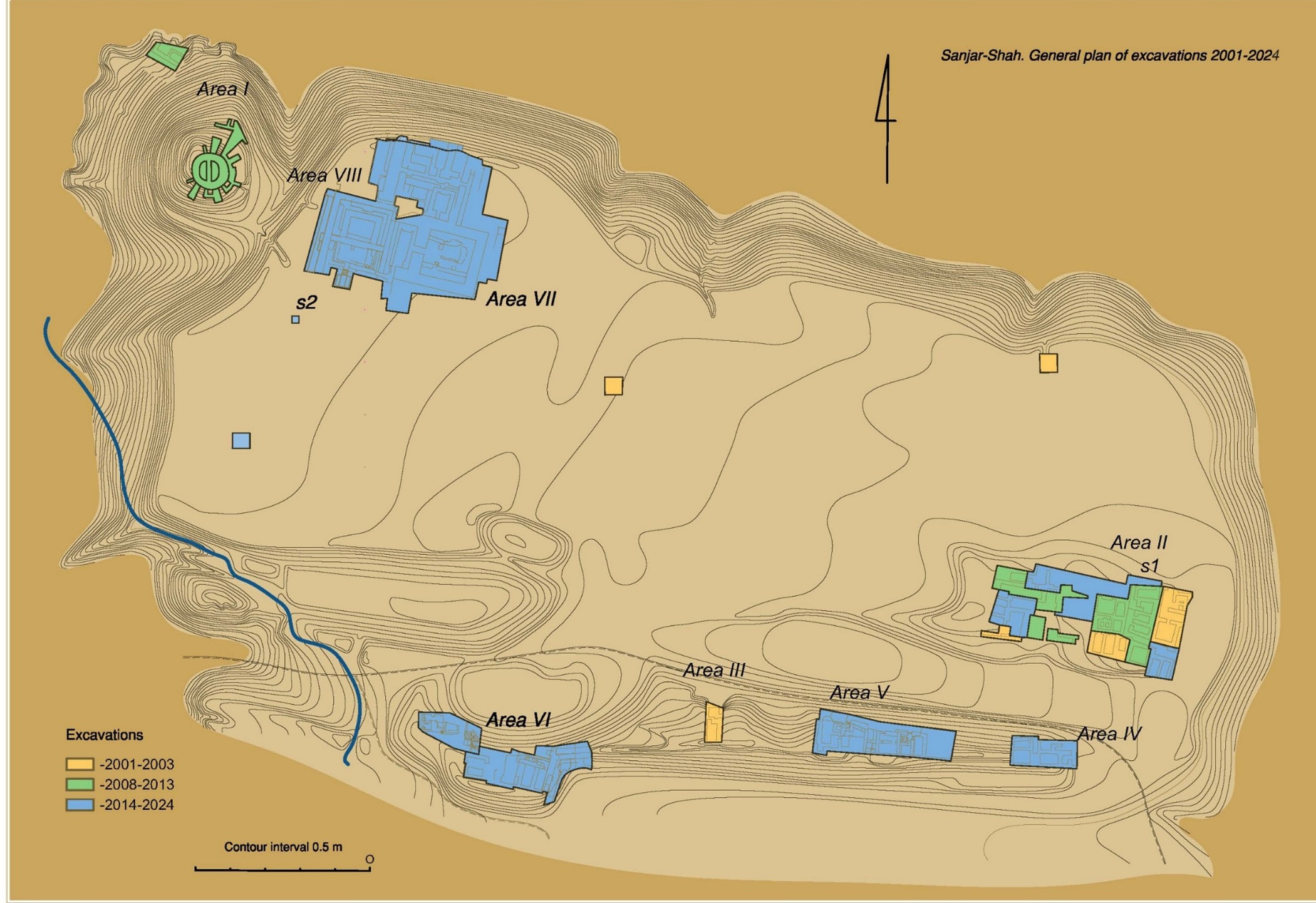
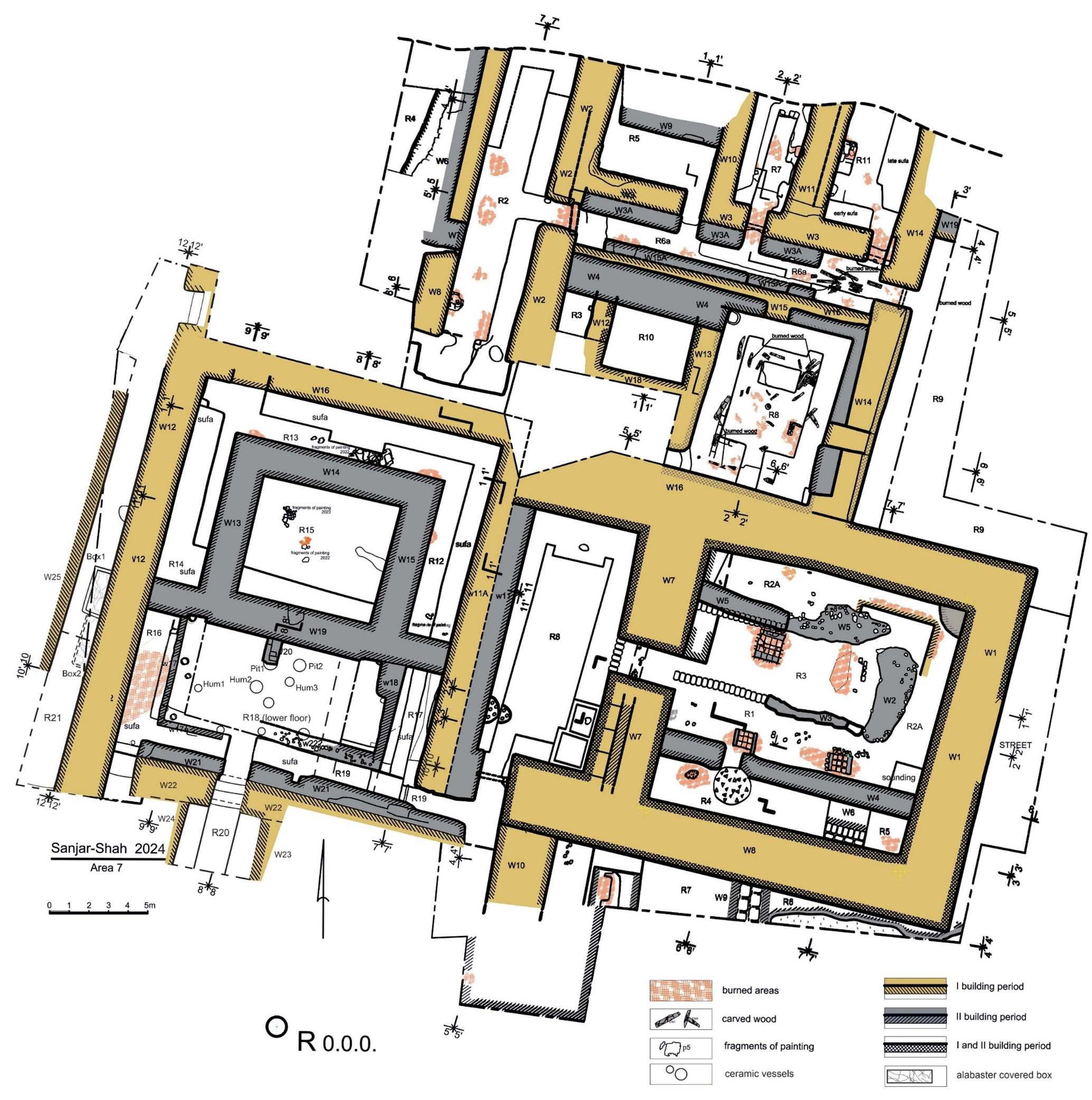
Fig. 2. Areas VIII-VII, the Palace, drawing by Alexey Akulov and Elena Bouklaeva
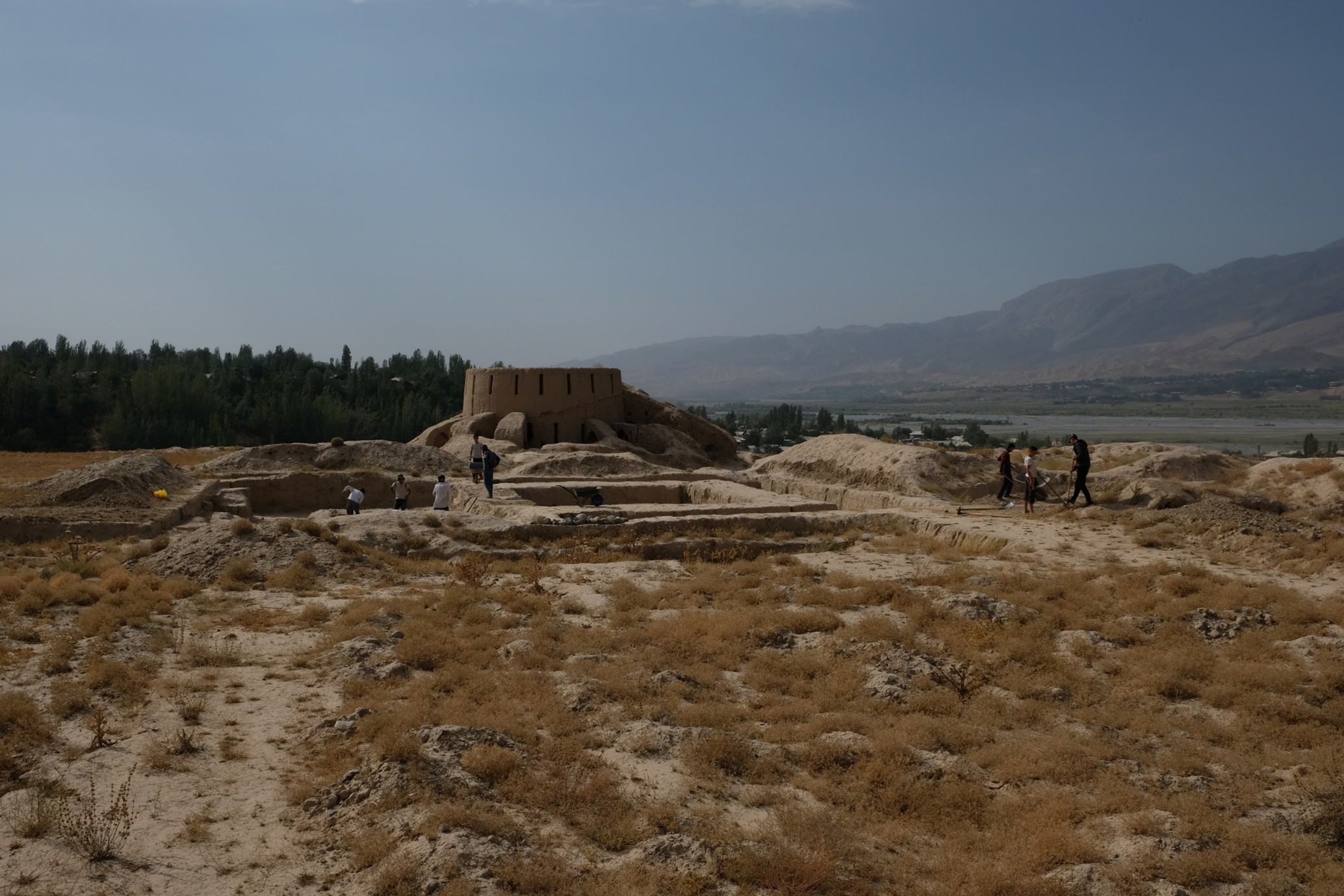
Fig. 3. Area VIII. Excavations in process
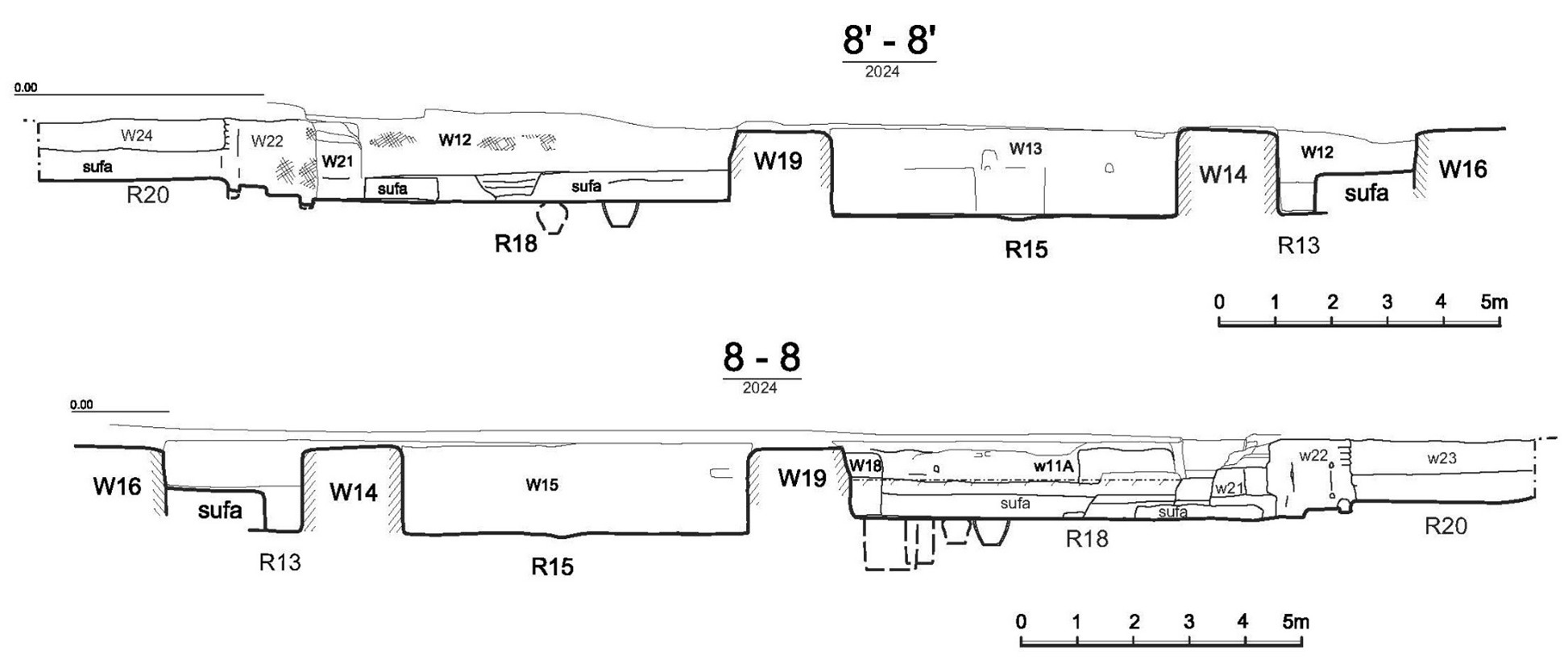
Fig. 4. Area VIII, section 8-8, drawing by Alexey Akulov
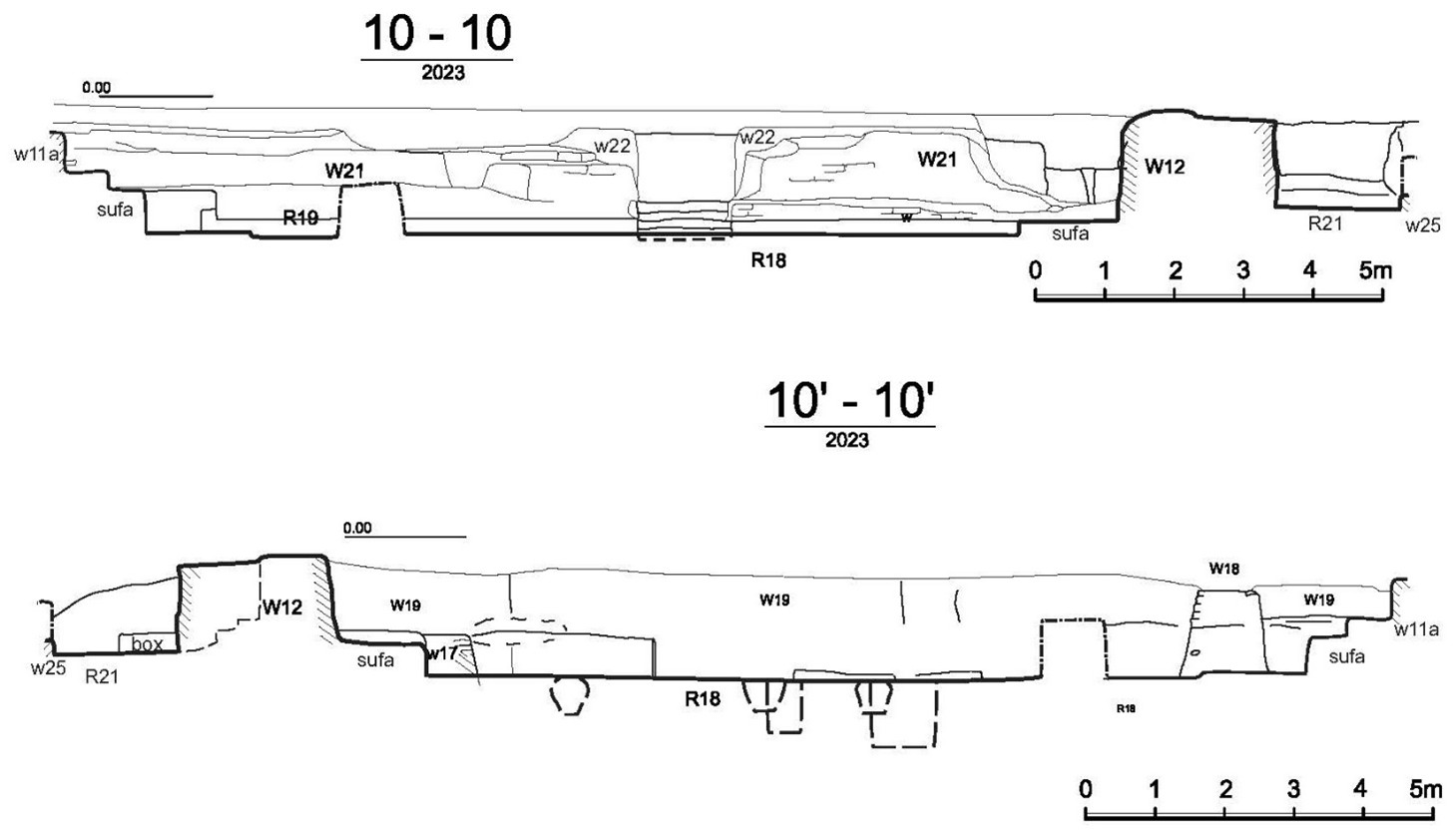
Fig. 5. Area VIII, section 10-10, drawing by Alexey Akulov

Fig. 6. Area VIII, section 12-12, drawing by Alexey Akulov
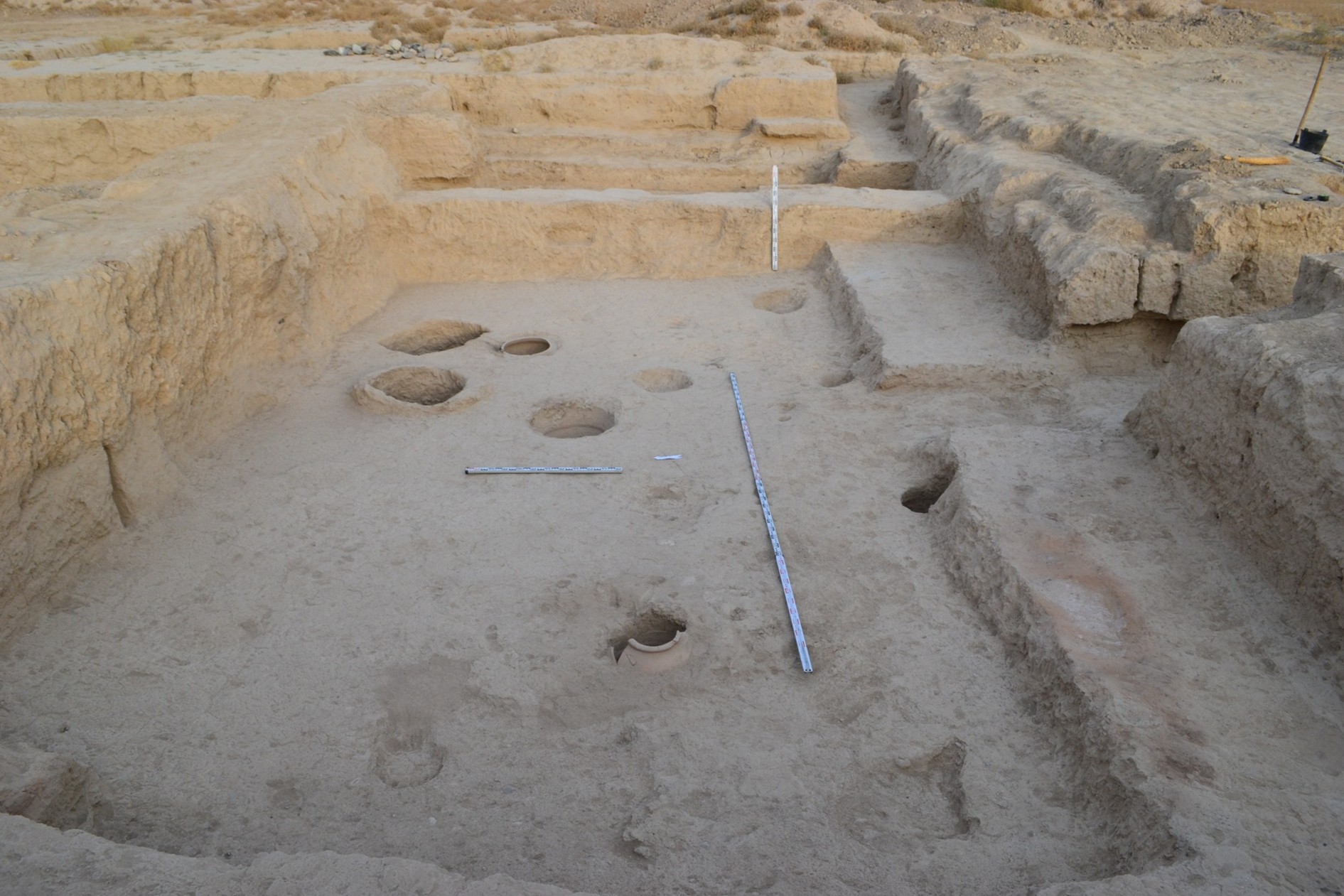
Fig. 7. Area VIII, Rooms 16-18 view from the west
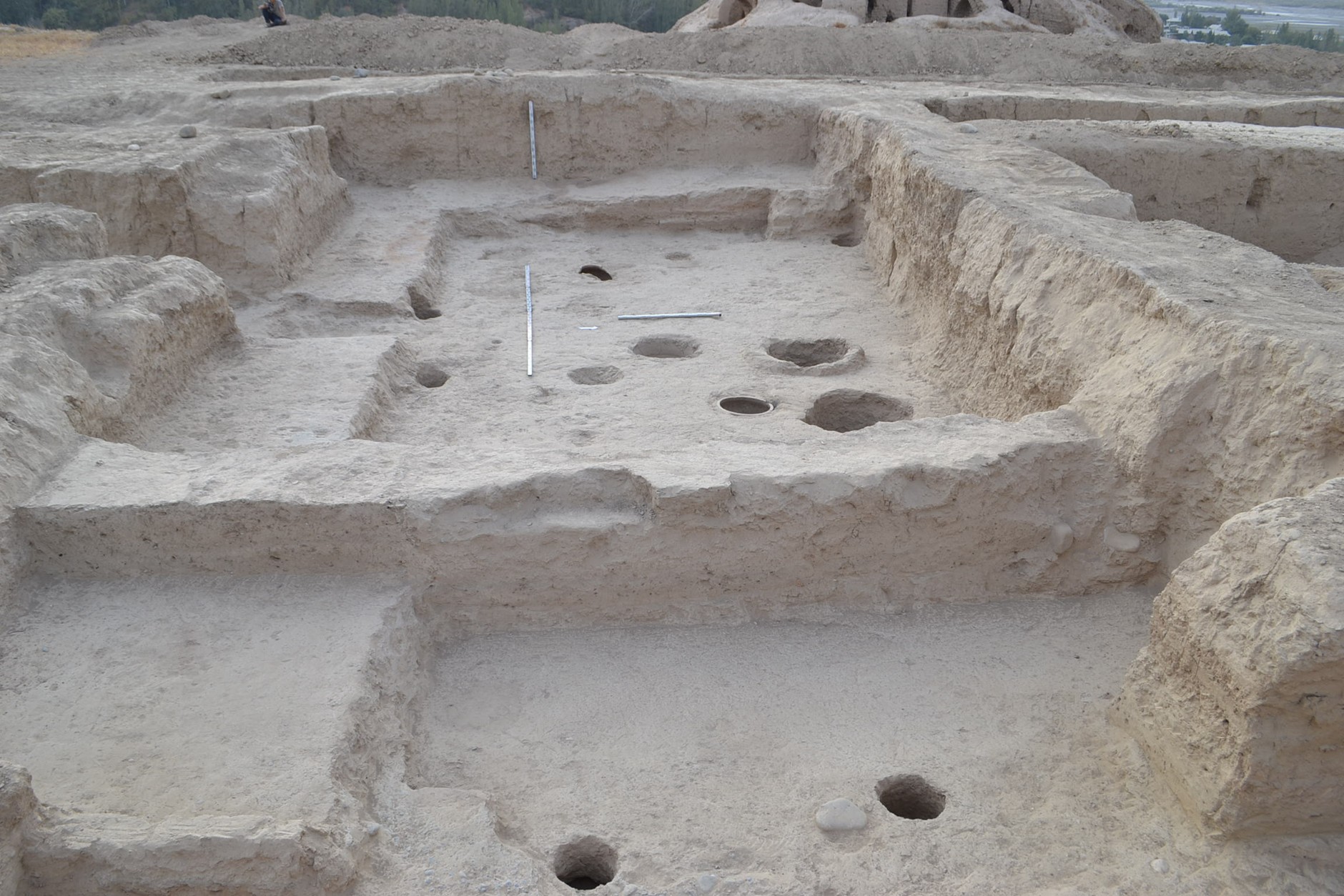
Fig. 8. Area VIII, Rooms 16-18 view from the east
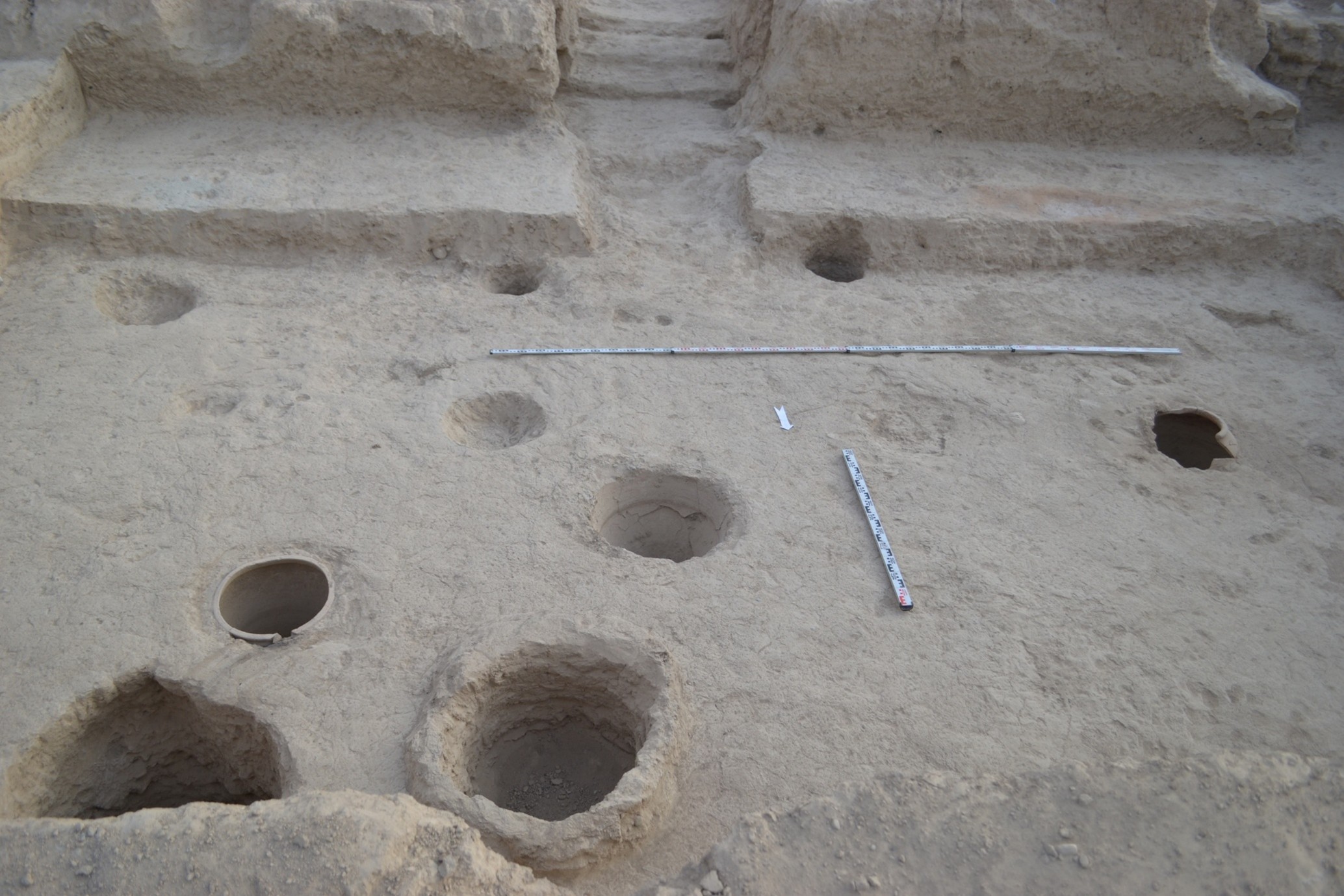
Fig. 9. Area VIII, Room 18, khums and pits in the floor
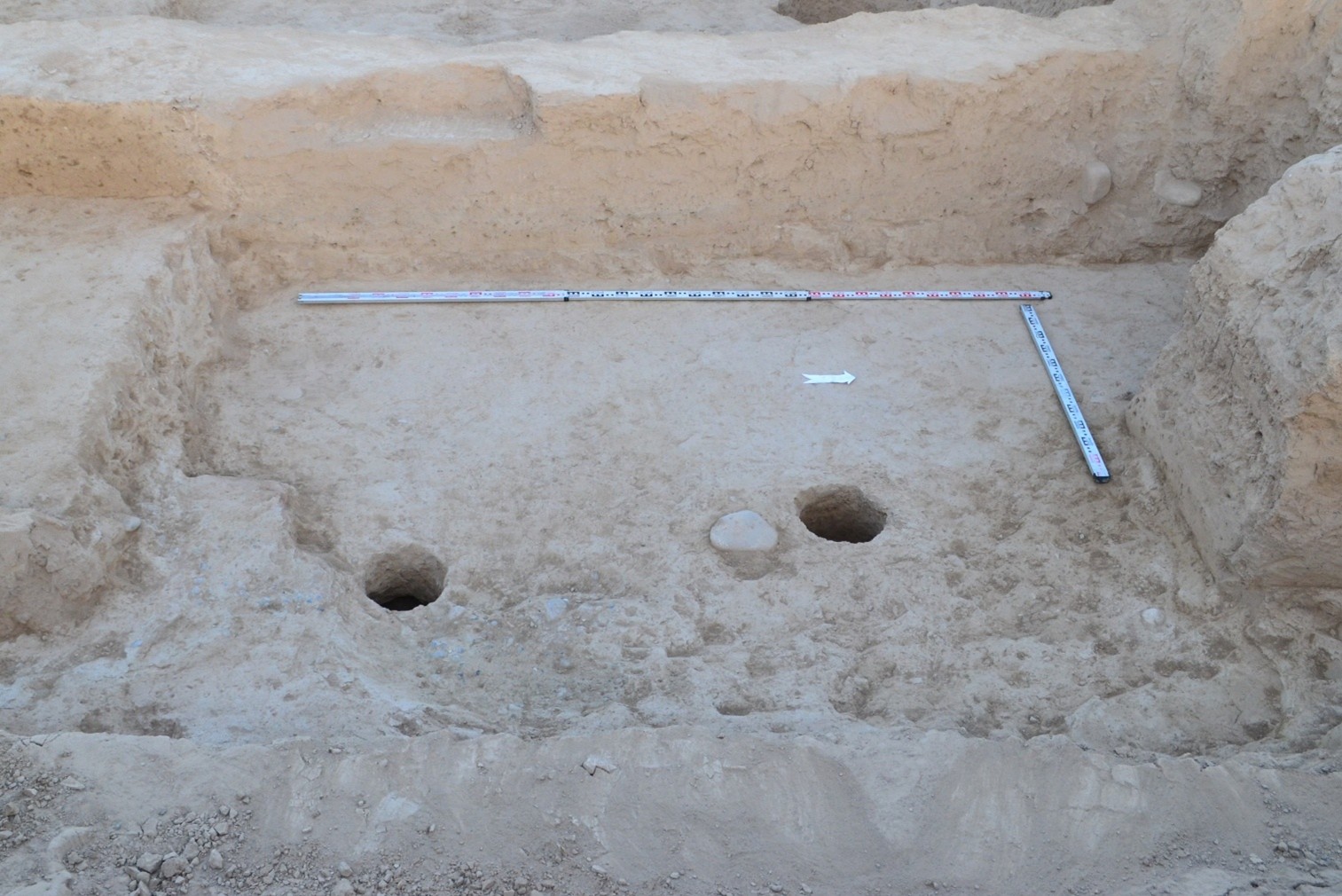
Fig. 10. Area VIII, Room 17, postholes in the floor
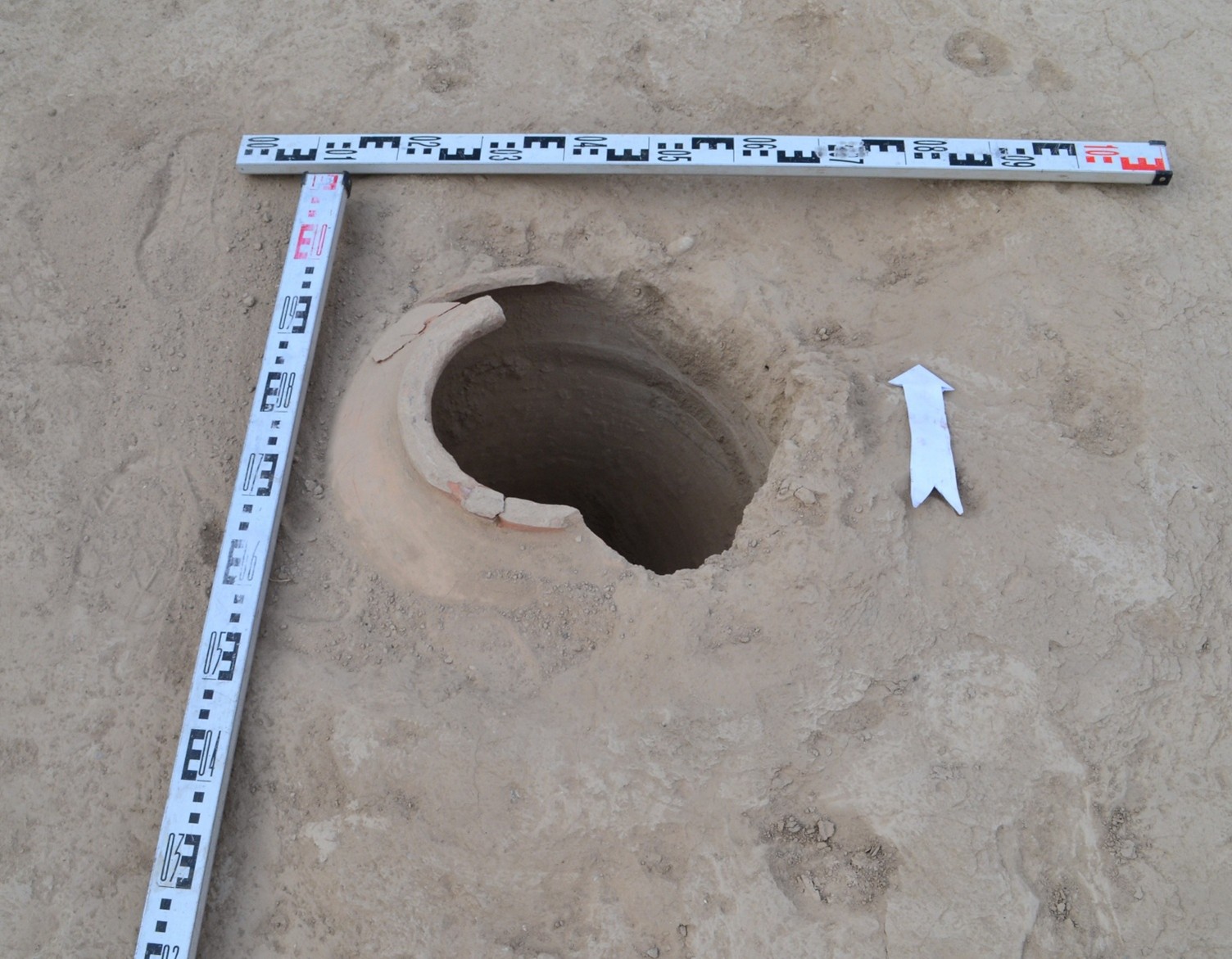
Fig. 11. Area VIII, Room 18, Khum 1
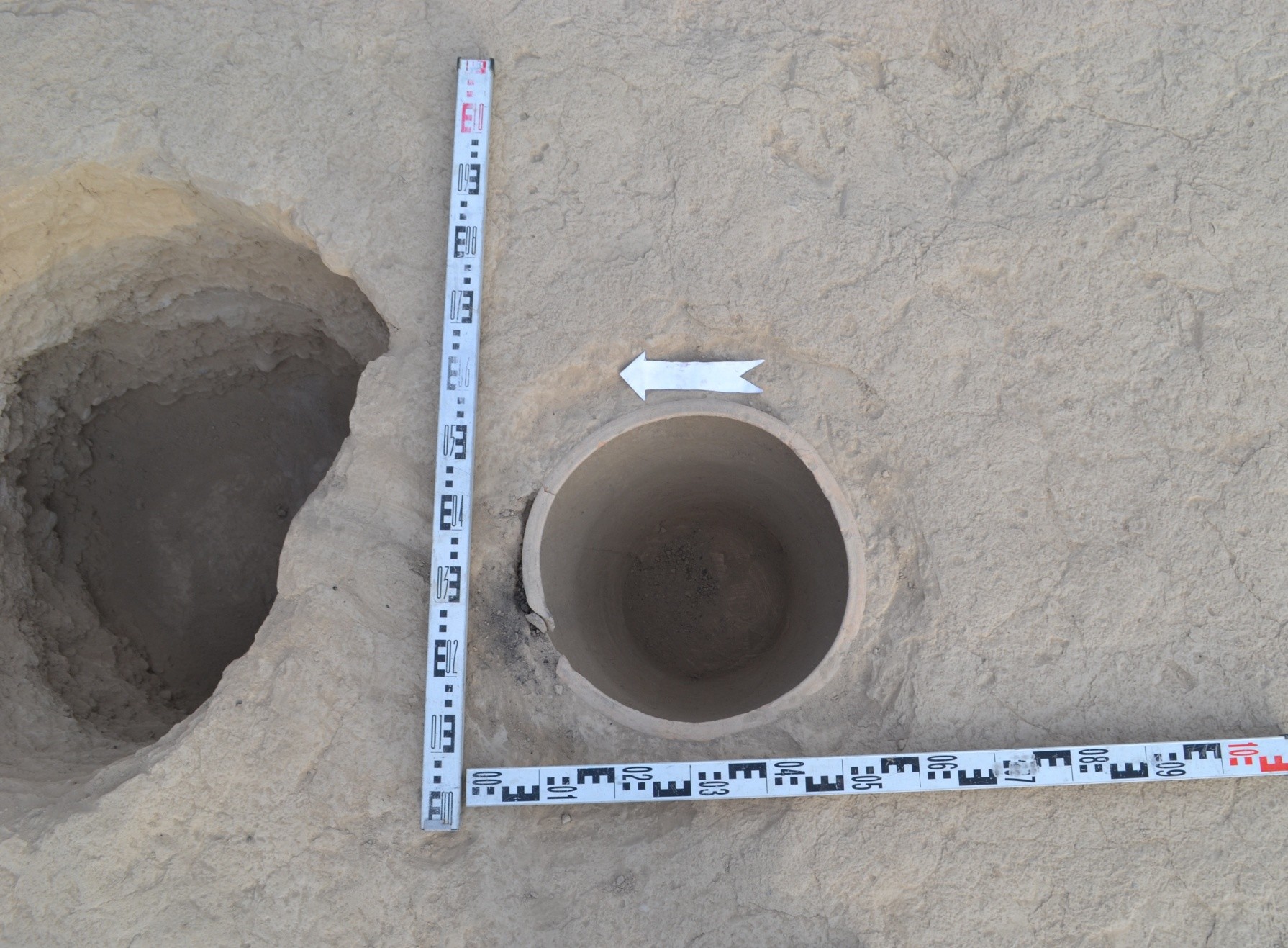
Fig. 12. Area VIII, Room 18, Khum 3

Fig. 13. Area VIII, Room 20 looking south
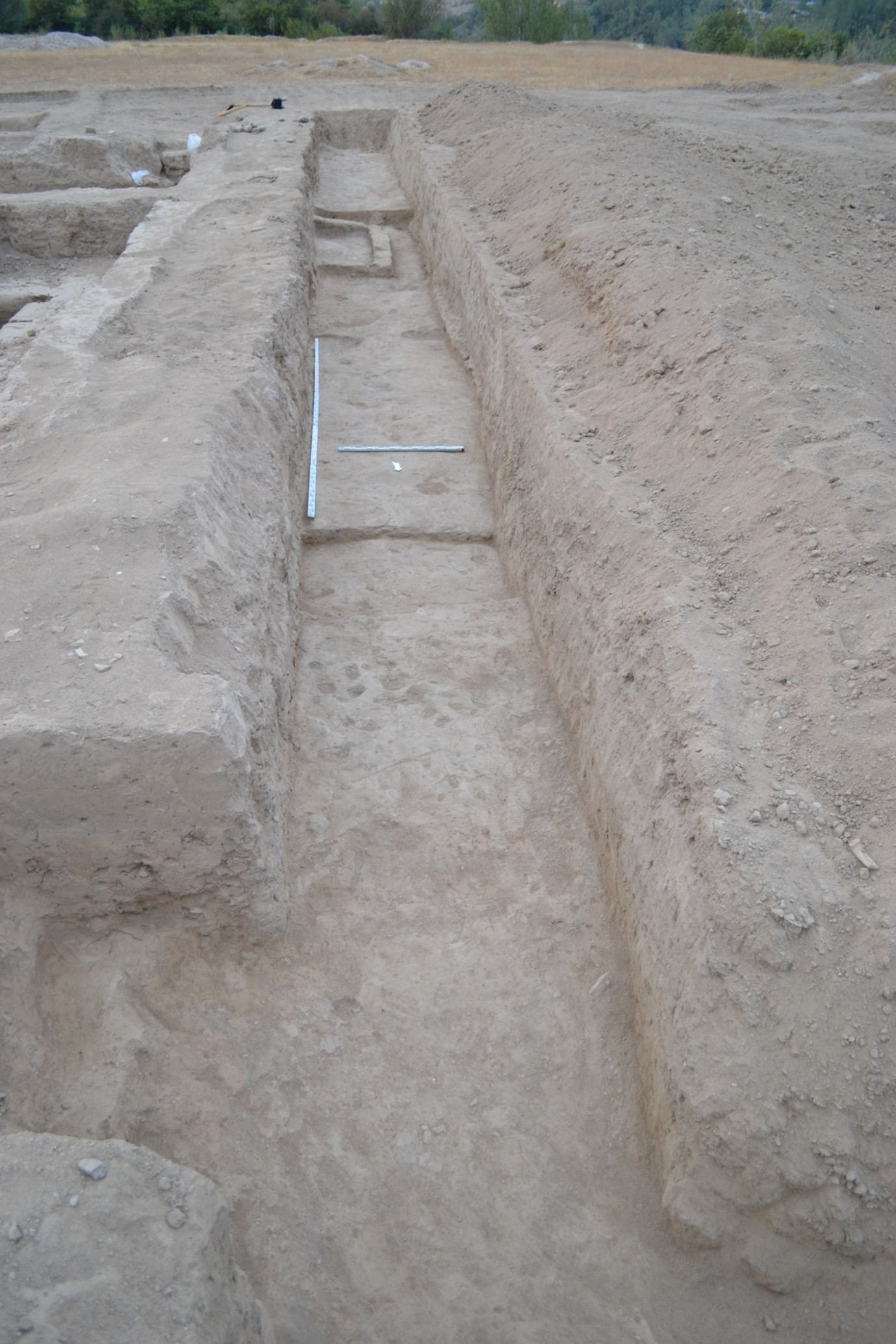
Fig. 14. Area VIII, Room 21 looking south
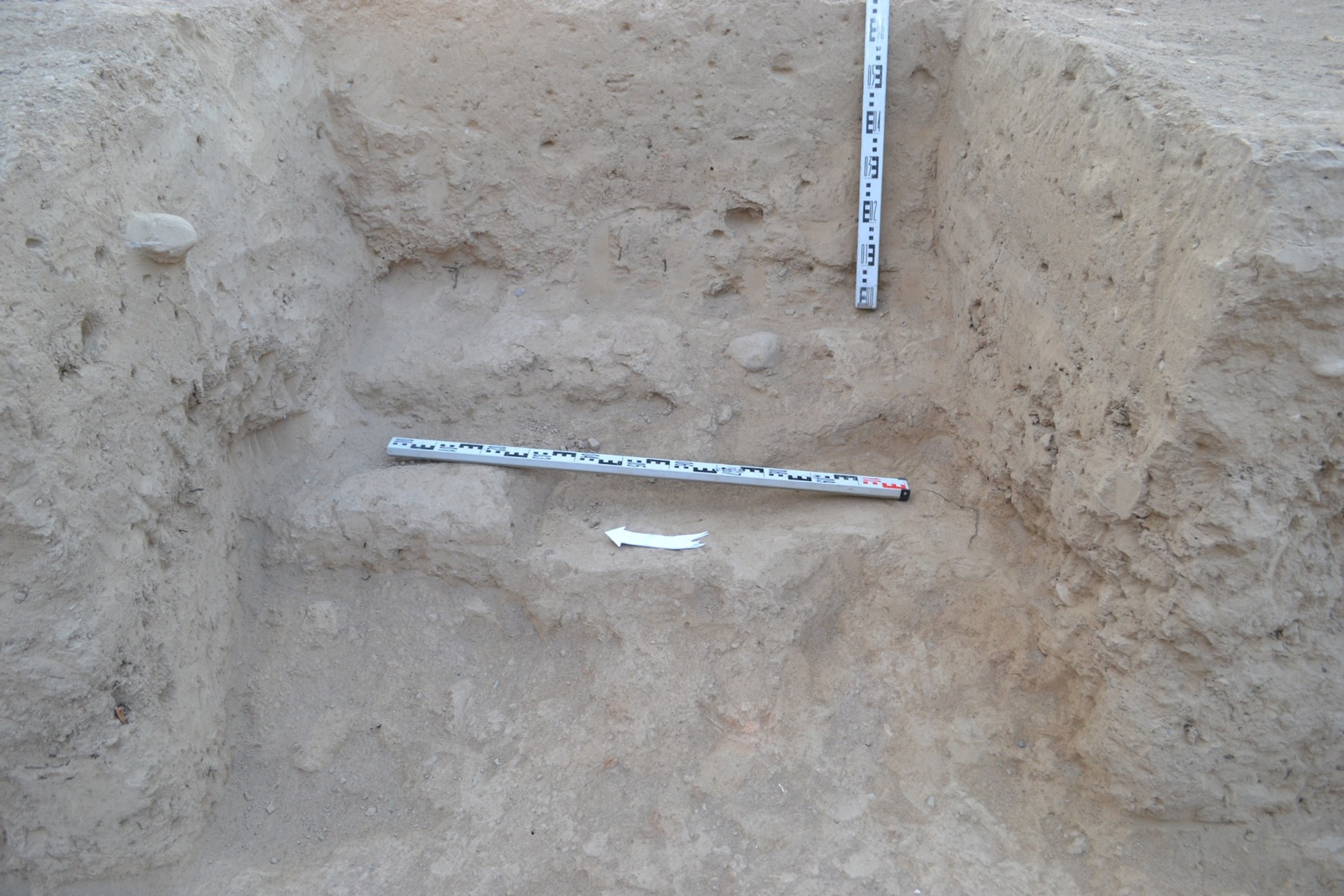
Fig. 15. Area VIII, Room 21, filled passage
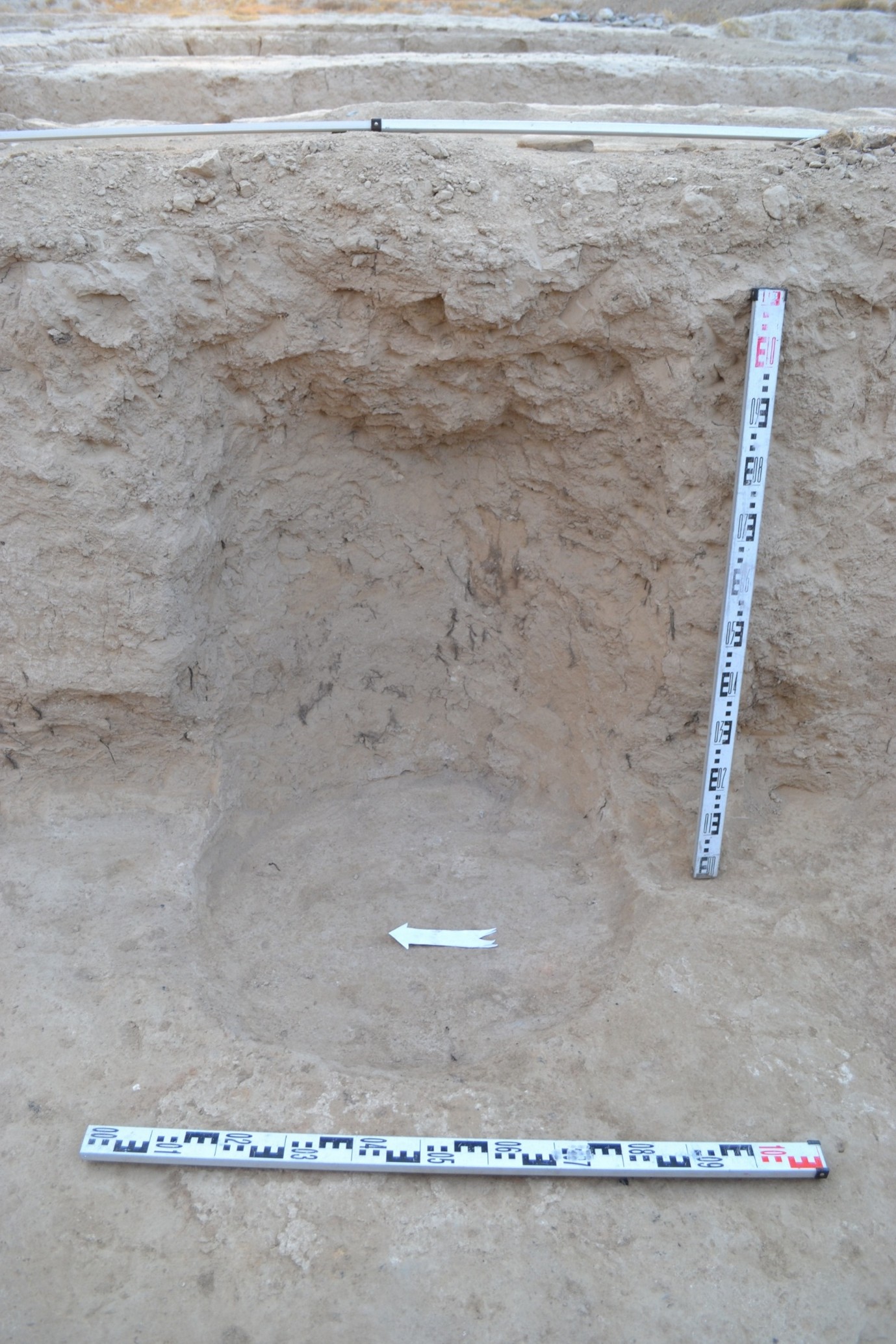
Fig. 16. Area VIII, Room 21, a hearth
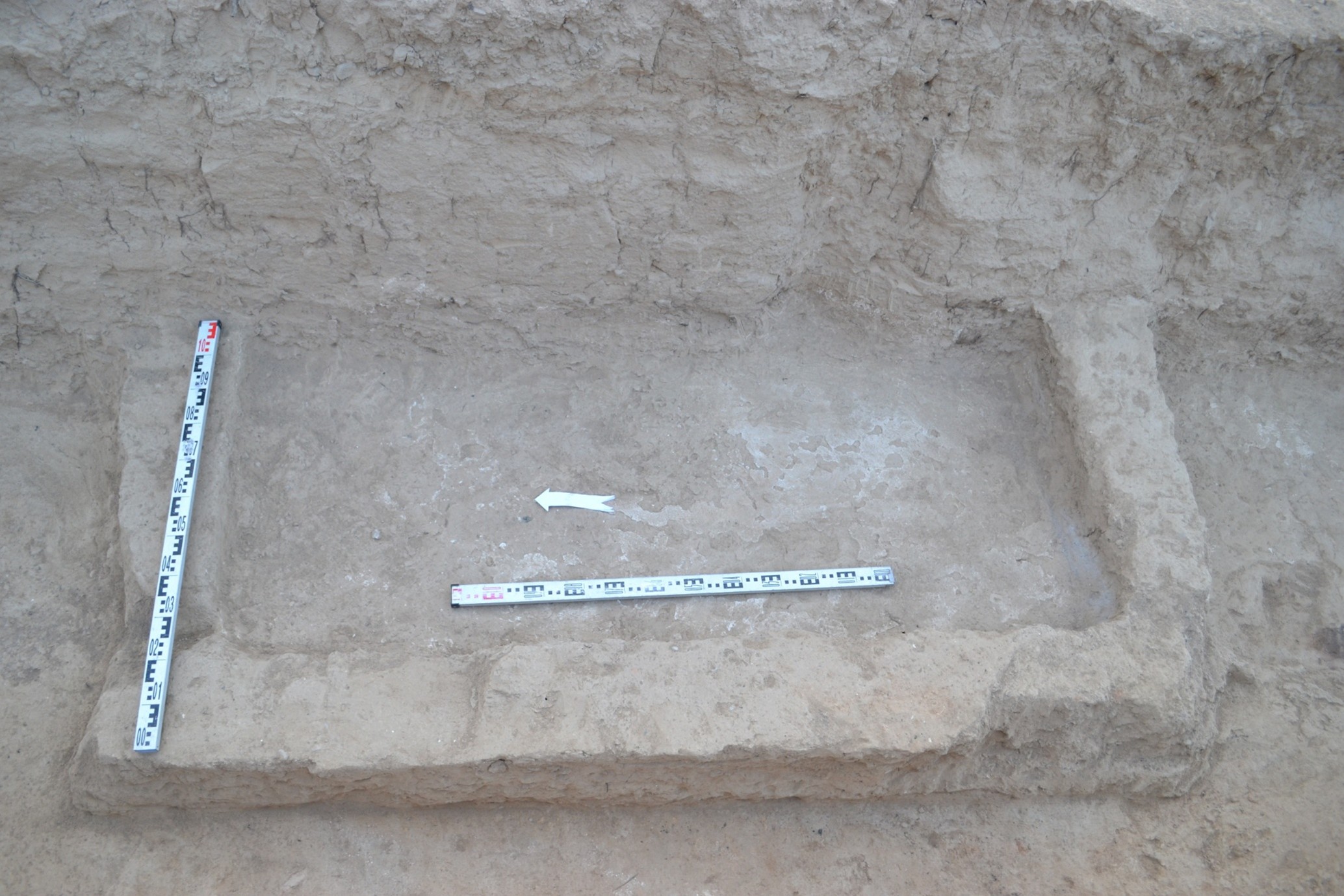
Fig. 17. Area VIII, Room 21, storage box
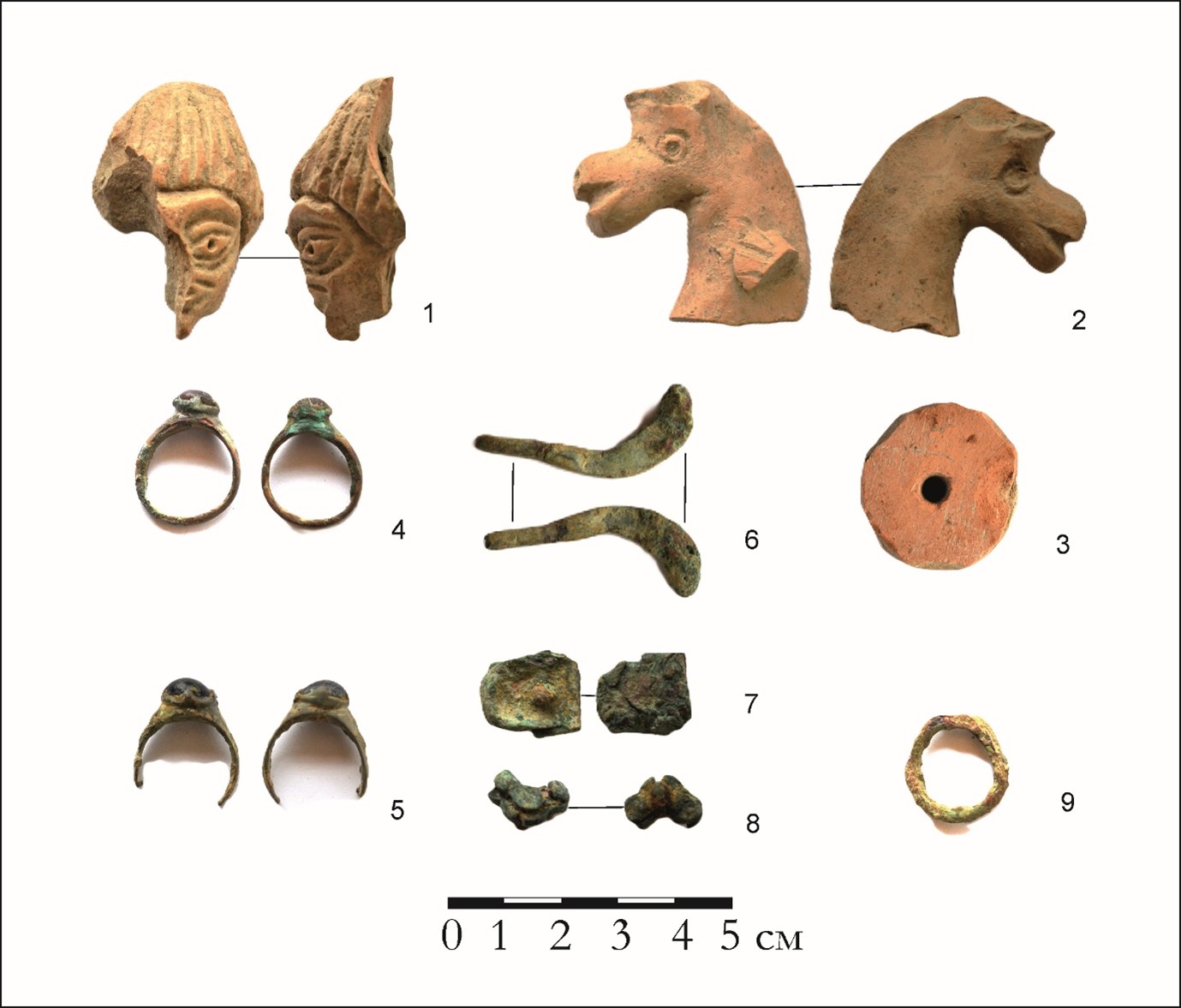
Fig. 18. Area VIII. Various finds. 1) Terracotta fragment in the shape of a human head. Fill of the second period; 2) Terracotta fragment in the shape of a (winged) horse’s head. Fill of the second period; 3) Ceramic spindle whorl. From the surface in the southern part of Room 21; 4) Bronze ring with blue glass paste. Found at a depth of 10 cm in the fill of Pit 2; 5) Bronze ring with red glass paste. Room 21, on the floor of Box 1; 6) Bronze item of unknown function, resembling a miniature sickle. Fill of the second period; 7) Belt tip and decorative plate. Bronze. Fill of Room 18; 8) Decorative belt plate. Bronze. Fill of Room 18; 9) Bronze ring. Room 18, found at a depth of 30 cm in the fill of Pit 2.
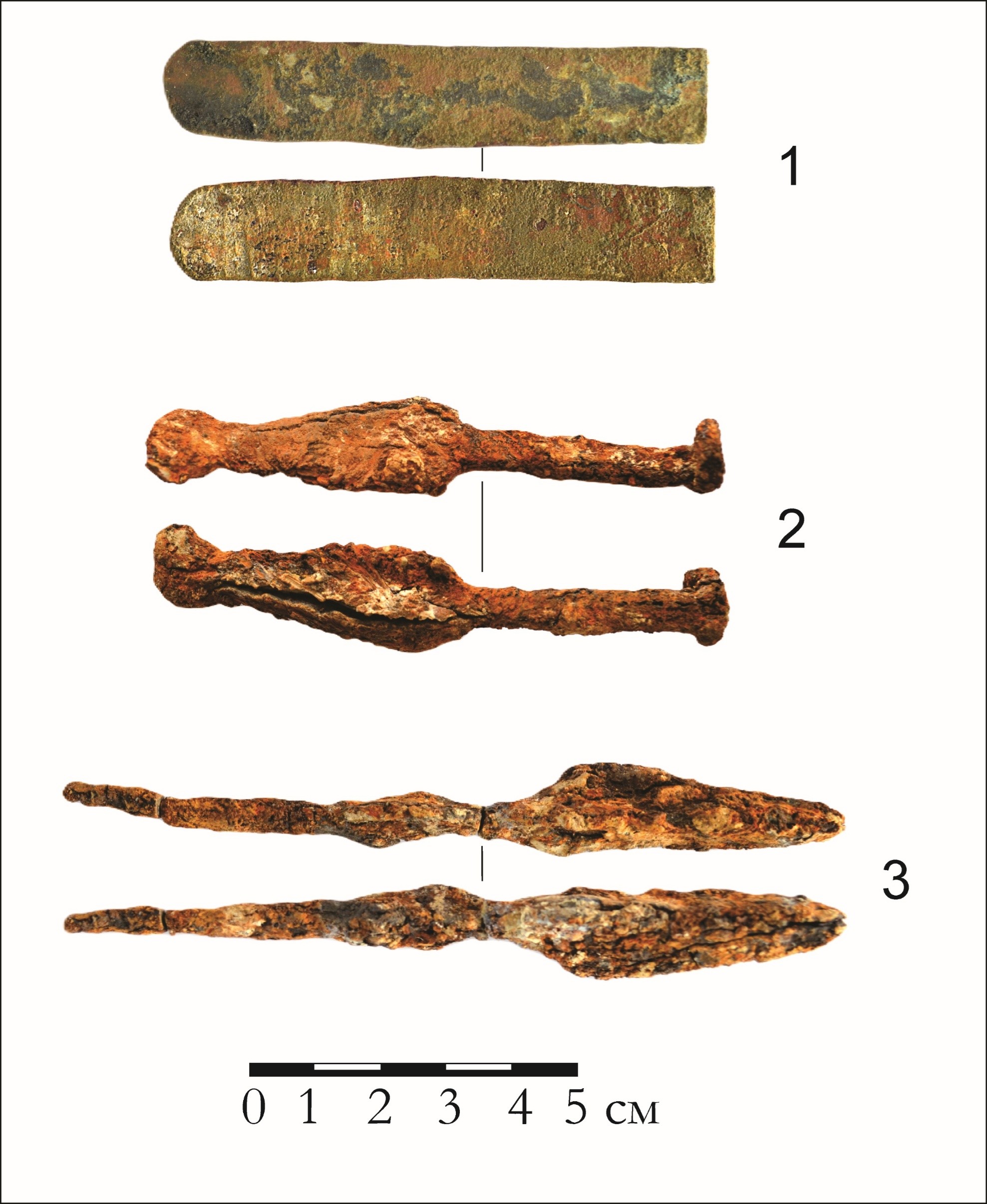
Fig. 19. Area VIII. Metal objects. 1) Bronze blank. Room 21, the floor of the second period; 2) Iron item resembling a key. Room 21, fill; 3) Iron arrowhead. Room 21, the floor of the second period.
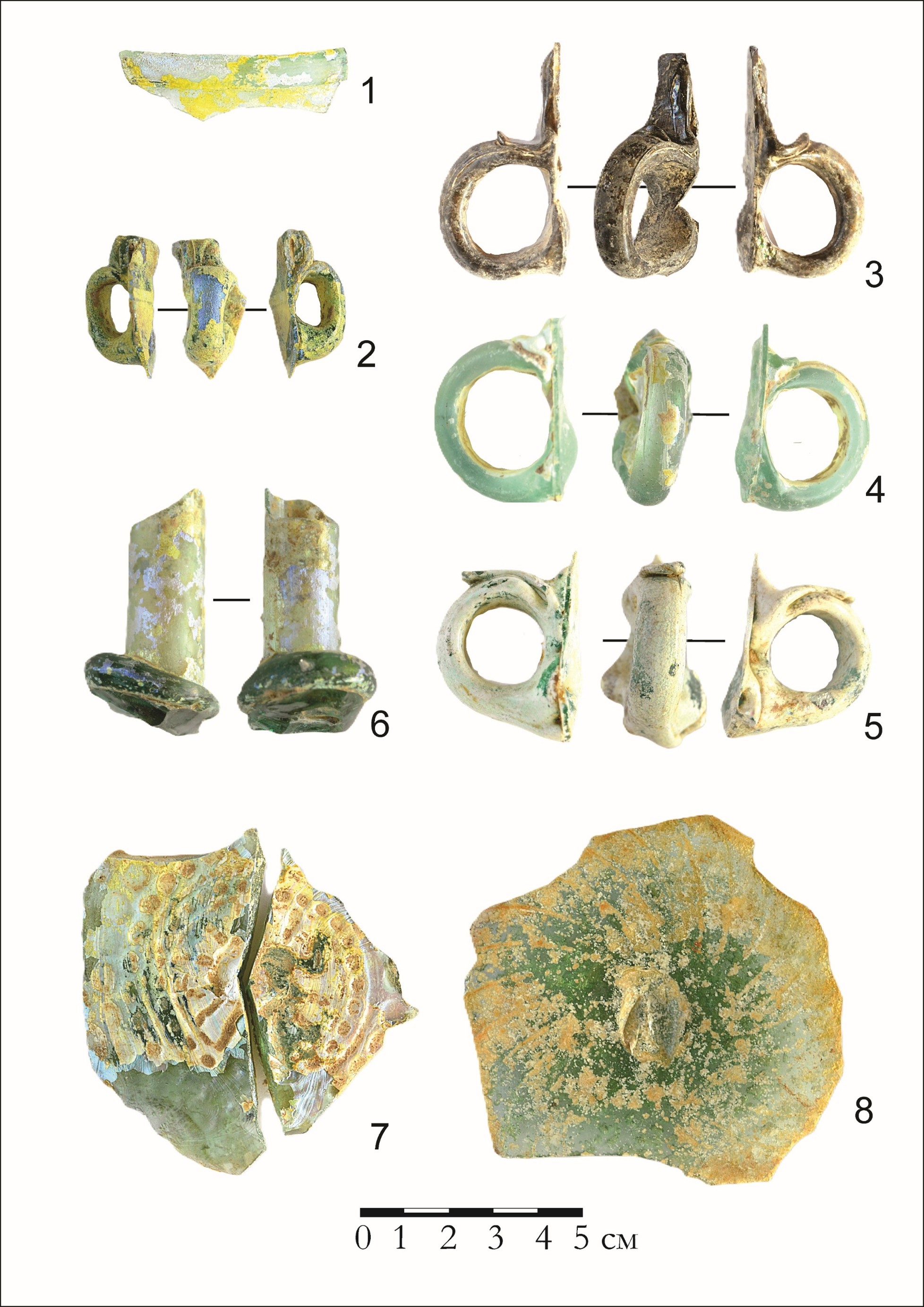
Fig. 20. Area VIII. Glass fragments. 1) Rim fragment of a glass vessel. Fill of the second construction period; 2–5) Handles of glass vessels; 6) Fragment of a glass item of unknown function; 7–8) Bottoms of glass vessels
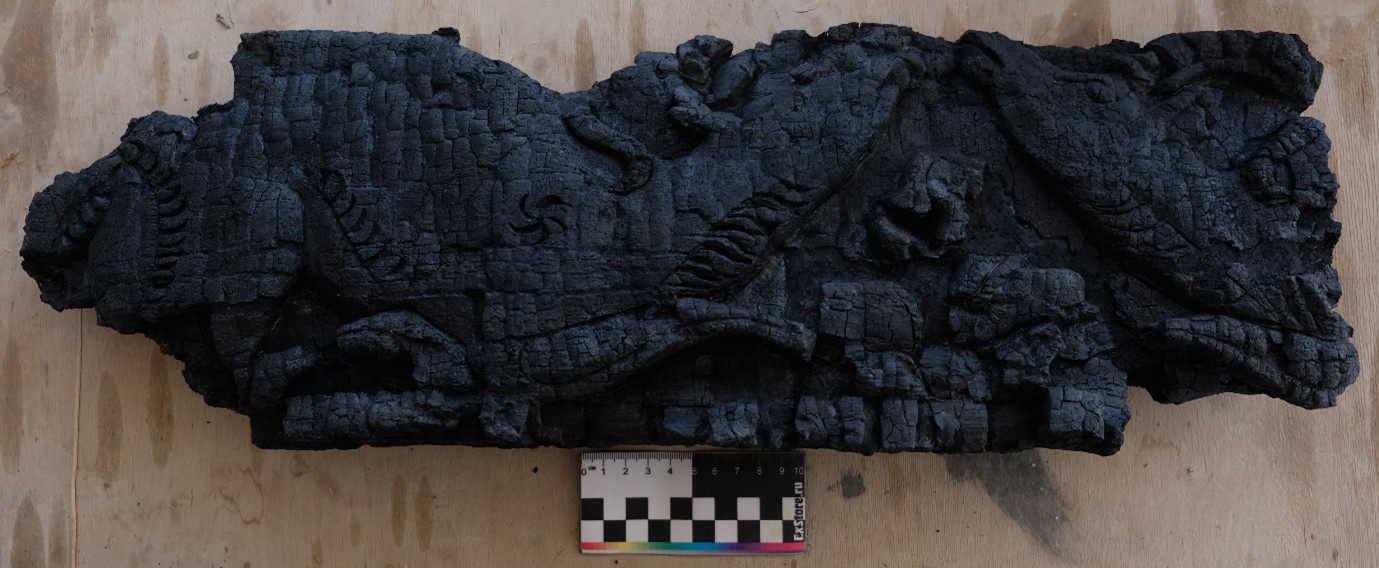
Fig. 21. Fragment of a wooden frieze depicting two crouching mountain rams facing a flower after the process of cleaning and restoration.
| copyright by The Society for the Exploration of EurAsia| E-mail | Home | ![]()